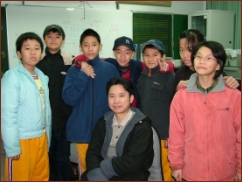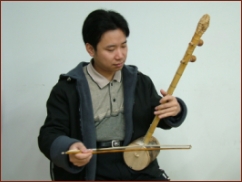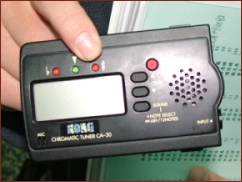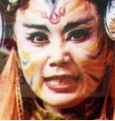|
|
 |
 Master of
Huqin-Huang Jia-jiun
Master of
Huqin-Huang Jia-jiun |
|  On
January 20th, 2005, Mr. Huang, Jia-jiun, the musician of the
Ming Hwa Yuan, was invited to our school to be interviewed
by us. He brought four kinds of stringed instruments, erhu
fiddle, ke zai sian(a shell-shaped stringed instrument),
da guang sian(a large, two-stringed Chinese mandolin), and
hexagon-shaped Chinese mandolin with him for the interview. On
January 20th, 2005, Mr. Huang, Jia-jiun, the musician of the
Ming Hwa Yuan, was invited to our school to be interviewed
by us. He brought four kinds of stringed instruments, erhu
fiddle, ke zai sian(a shell-shaped stringed instrument),
da guang sian(a large, two-stringed Chinese mandolin), and
hexagon-shaped Chinese mandolin with him for the interview.
Mr. Huang was from Mainland China. He learned to play huqin(a
certain kind of two-stringed bowed instrument)since he was
seven years old. After he married a Taiwanese musician of
Chinese Music, he began to settle in Taiwan. We are curious
about how he became a full-time musician for the Ming Hwa
Yuan since he used to know nothing about Taiwanese Opera before
his came to Taiwan. Huang admitted that he really didn’t
know anything about Taiwanese Opera, not to mention its particular
music accompaniment. However, after he settled down in Taiwan,
he learned more about Taiwanese Opera through TV, theater
houses and the philharmonic. Then with recommendation from
his colleagues in the Chinese philharmonic society and his
excellent huqin skill, he was hired by the Ming Hwa Yuan and
became its full-time musician.
|
 Comparison
with Four Stringed Instruments
Comparison
with Four Stringed Instruments |
|  The
stringed instruments brought by Mr. Huang are all common in
the accompaniment of Taiwanese Opera. Mr. Huang shared with
us his experiences about playing these instruments. Nanhu,
so-called erhu, which Mr. Huang plays best, is also the most
difficult to master. He learned to play erhu since he was
very young. The sound of erhu is dulcet and has very dramatic
powerful to cope with different scenes in a drama. After musicians
adopted the Occidental playing skills of stringed instruments,
the artistic power of erhu is further reinforced. Therefore,
erhu is also internationally known as the “Chinese violin”. The
stringed instruments brought by Mr. Huang are all common in
the accompaniment of Taiwanese Opera. Mr. Huang shared with
us his experiences about playing these instruments. Nanhu,
so-called erhu, which Mr. Huang plays best, is also the most
difficult to master. He learned to play erhu since he was
very young. The sound of erhu is dulcet and has very dramatic
powerful to cope with different scenes in a drama. After musicians
adopted the Occidental playing skills of stringed instruments,
the artistic power of erhu is further reinforced. Therefore,
erhu is also internationally known as the “Chinese violin”.
Da guang sian(a large, two-stringed Chinese mandolin) is
Huang’s favorite instrument. It has a unique diapason, and
it sounds like human weeping.
The sound of hexagon-shaped Chinese mandolin is tender and
lucid; it especially goes perfectly with actors singing voice.
Hexagon-shaped Chinese mandolin only exists in Taiwanese Opera.
Ke zai sian(a shell-shaped stringed instrument)was unique
to Chi Zi Diao (Seven-Syllable Melodies) of Taiwanese Opera.
After Taiwanese Opera won popularity in Mainland China, ke
zai sian also became one of the major instruments for the
accompaniment of Taiwanese Opera in both cross-strait areas.
|
 The All-embracing
Ming Hwa Yuan
The All-embracing
Ming Hwa Yuan |
|  Mr.
Huang told us that in the Ming Hwa Yuan, most male leads(siao
sheng)sing in C major and D major, while female leads(siao
dan)sing in F major and G major. Ms. Suen Tsuei-feng sings
in E flat major. Huang also showed us his electronic tuner
with which he could find a fixed music score & fixed tunes
for Taiwanese Opera troupes. Mr.
Huang told us that in the Ming Hwa Yuan, most male leads(siao
sheng)sing in C major and D major, while female leads(siao
dan)sing in F major and G major. Ms. Suen Tsuei-feng sings
in E flat major. Huang also showed us his electronic tuner
with which he could find a fixed music score & fixed tunes
for Taiwanese Opera troupes.
Mr. Huang also told us that there are more types of music
for voices in the Ming Hwa Yuan than any other Taiwanese Opera
troupes, because the Ming Hwa Yuan can accept more unconventional
ideas. For example, if there is a foreigner in the story,
musicians will have to play Occidental music with Chinese
instruments. We asked Mr. Huang to demonstrate a bit of Occidental
cartoon music with his instrument. It was really amusing!
|
|



